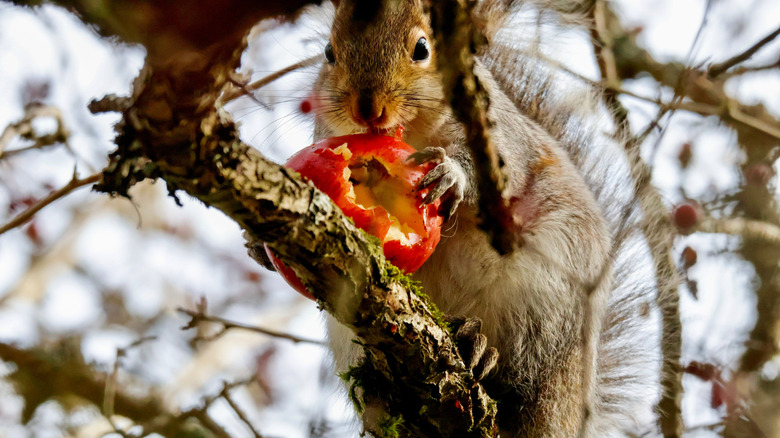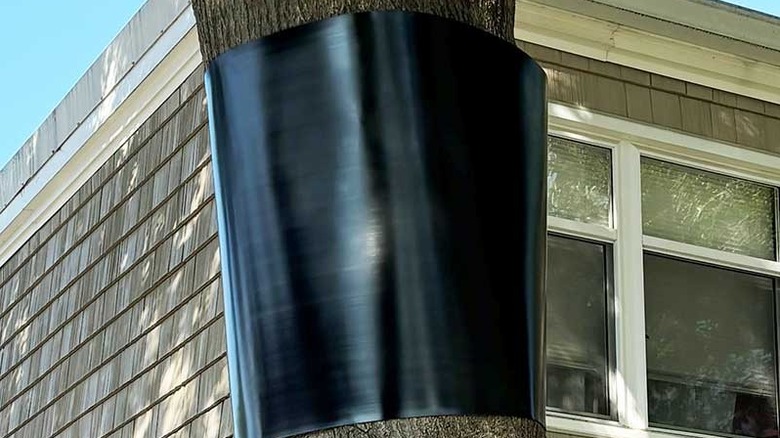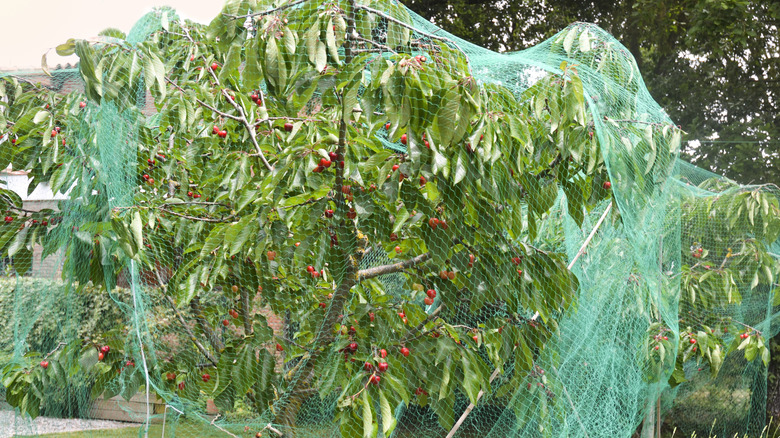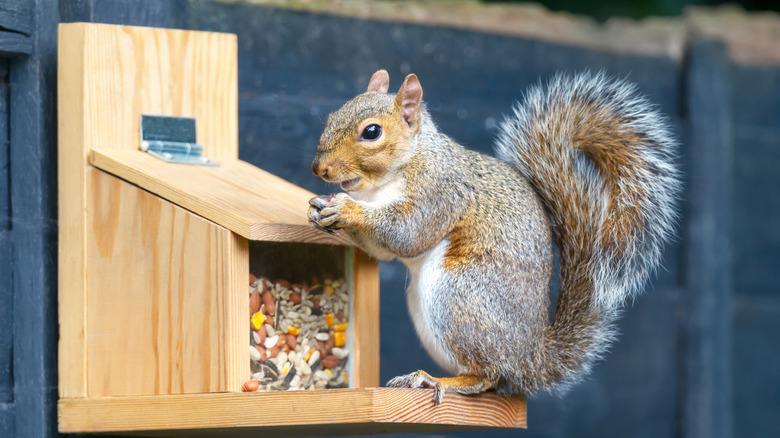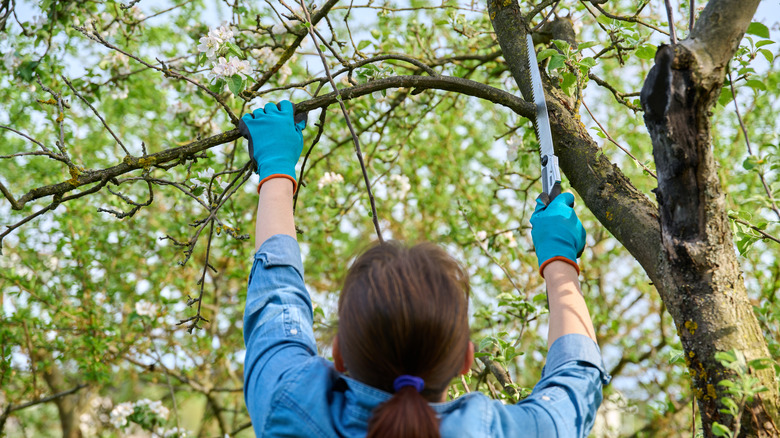The Best Ways To Keep Squirrels Away From Your Precious Fruit Trees
We may receive a commission on purchases made from links.
Gardeners with fruit trees may find themselves at wit's end as they survey the damage squirrels can leave behind. These critters are incredibly tenacious and will often stop at nothing to reach their target: your fruit tree. The daring, energetic acrobatics they perform don't just damage the crop — they can also harm your tree by stripping the bark, leaving it susceptible to disease or pest infestation. To reduce the risk of this occurring and to protect your crop, you can keep squirrels away from your fruit trees with a variety of methods. These include adding obstacles, netting your trees, distracting them with an alternative, making branches less accessible, and using motion-activated sprinklers.
While these methods are helpful, they aren't exactly foolproof. Squirrels have incredible problem-solving skills, and mixing up your approaches you use regularly can help you stay one step ahead of the shrewd thinkers. These clever strategies are an excellent alternative to harsh chemicals or pesticides, humane, and environmentally-friendly, plus relatively easy to implement. Don't get frustrated with the squirrels eating your fruit. Follow some or all of these tips to discourage them away from your fruit trees so you have a thriving harvest.
Install a baffle so squirrels are baffled on how to climb
One of the easiest and most common ways to prevent squirrels climbing in trees is with a baffle (tree guard). This is a cylindrical plastic or metal shield that fits around your tree's trunk to prevent squirrels from climbing to reach the fruit. Baffles are used as a way to keep squirrels away from your bird feeder, and they work just as well with fruit trees, preventing both the theft of your fruit and guarding against bark damage caused during the squirrels' pursuit. As the creatures try ascending the tree to get to the good stuff, they will quickly find they can't get a solid grip, and instead, slide back down.
Baffles feature adjustability so they can easily fit your tree's trunk, letting you widen them to accommodate for new growth. They don't affect your tree's growth or harm it once installed. You can purchase one from most gardening supply or feed stores. If you're handy with a jigsaw, you can also make your own baffle out of a piece of sheet metal by cutting a square larger than the tree's trunk, then rolling the metal into a cone. An alternative DIY baffle option is to cut a hole the bottom of a 5-gallon paint bucket, adding a v-shaped notch in the plastic to expand it so it may easily wrap around the tree. Use eyebolts and wire to attach it to the tree by hanging it via a set of branches.
Protect your trees with netting
Another way of protecting your fruit trees from squirrels is with wildlife-safe tree netting which basically insulates the entire tree, branches and all, with a physical barrier. Using this method might be a little cumbersome if you have tall fruit trees, requiring a ladder or a reaching pole for placement. As an added bonus, netting also helps with keeping birds out of your precious fruit tree while still permitting pollinators access to the blossoms inside. It also keeps your fruit secure until it's ready for harvest.
Before you fully cover your tree, double check to ensure you don't trap any nesting birds or squirrels inside the net. Once clear, anchor the netting at the bottom of the tree, tying it tightly to prevent any squirrels or other animals from sneaking in. You should periodically inspect for any holes or gaps, as even small openings may let critters easily slip inside, or worse, trap them. Tree nets can vary in material quality, so research carefully for the best durable options. Rips can quickly spread and compromise the net's integrity, so fix any rips as soon as you notice them, or replace the netting entirely if it's beyond repair.
Feed squirrels as a deterrent
Protecting your fruit trees from a squirrel invasion might be as easy as offering a distraction. Draw their attention away from the trees by setting out their own feeder, or at the very least, leave out a few nuts for them. Use a squirrel-specific feeder such as a Squirrel Feeder Bowl, setting it as far away from the fruit trees as your yard allows. Next, fill it with corn cobs, nuts, and black oil sunflower seeds. You can also opt for nutritious options like walnuts and hickory nuts, which are great for squirrels' health plus can be fed still in the shell.
Don't forget to place a water source near their feeding area. Not only will this make the spot more inviting, but it also will keep squirrels from chewing on your sprinkler heads or hoses when they're thirsty. You can use a small bird bath or just a raised, shallow dish at ground level. Be sure you change the water daily to prevent mosquitoes breeding in any stale, stagnant water.
Trim branches to reduce accessibility
Squirrels often access trees from the ground by quickly scurrying up the trunk, but they can also reach them from the air. With the ability to jump more than 6 feet from branch to branch, they often seem to fly in from telephone poles or nearby trees. You can reduce their access to your fruit trees by trimming away any nearby overhanging branches, especially those near your roof line, offering them less "runway" to execute their jaw-dropping aerial leaps.
Be careful you don't cut too much off your tree if it's already pruned. Over-pruning is detrimental to your tree's health, plus it can damage the fruit production as the tree needs to redirect energy towards healing the cuts. If you aren't sure how to properly prune your fruit trees, hire a professional service for the task. You can try trimming your tree branches in combination with installing a baffle to launch a double defense against the squirrels' rampage.
Shock them with sensor-activated sprinklers
A popular way to keep squirrels from even thinking about your yard is by using motion-activated sprinklers. If you already have a sprinkler system in your yard, adding this option shouldn't be too difficult. When a squirrel ventures too close, the sprinkler will go off with a blast of water. The resulting spray and its sound will then startle them. After this experience, it should hopefully cause them to avoid your trees in the future. Squirrels have good memory recall for locations, and they can remember what's a good food source and what isn't. For the most effective results, set your sprinkler heads pointing at the base of the fruit tree(s).
Most sprinkler options available, like AbcoTech Motion Activated Sprinkler/Animal Deterrent, will let you fine-tune the motion sensitivity, spray direction, and jet strength. Don't forget to turn off the settings when you go outside to tend to your trees, or you'll be on the receiving end of the blast. However, if you frequently have deer or rabbits intruding in your garden, the motion-activated sprinkler can help ward off these critters as well.
